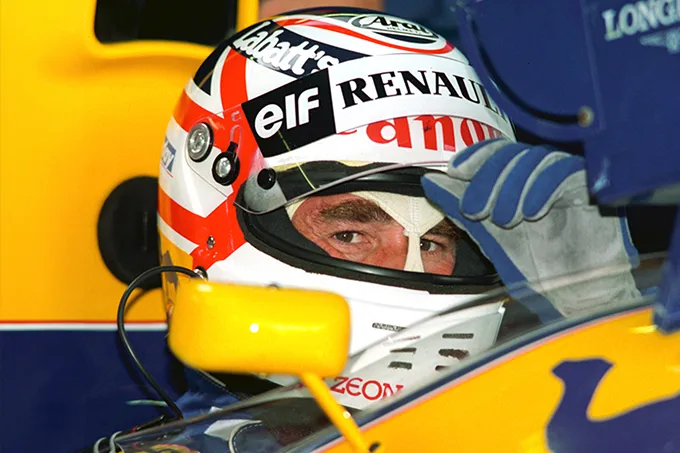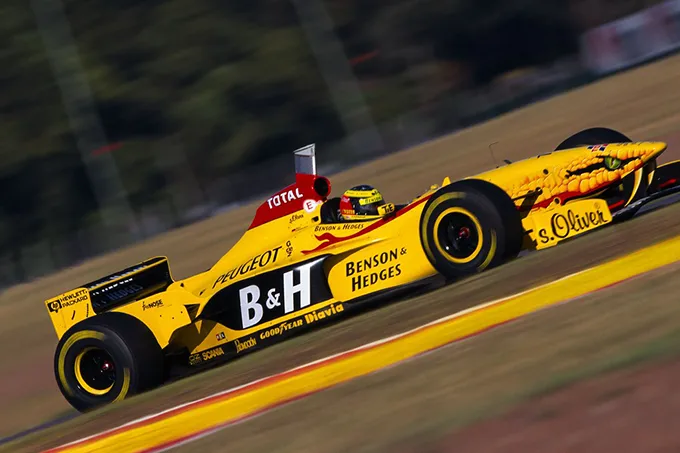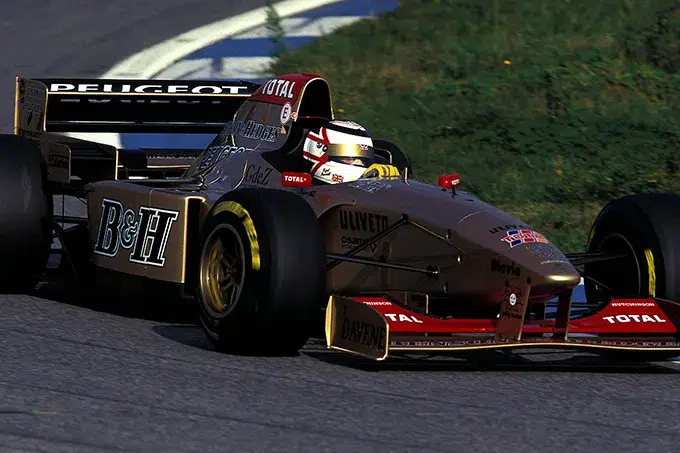In 1997, Nigel Mansell almost returned to F1 with Jordan, a decision that could’ve changed the team’s fortunes.
In 1994, the 1992 World Champion, Nigel Mansell, made his comeback with Williams F1 towards the end of the year.
The tragedy at Imola and Ayrton Senna’s death led Mansell to become a high-profile stand-in for Williams F1, replacing a still-too-inexperienced David Coulthard. Mansell notably secured pole position in Adelaide before claiming his final victory, also delivering the constructors’ title to Williams F1. We know what happened next: for 1995, Frank Williams dismissed the veteran lion to bring back Coulthard.
Yet, given his strong end to the year, Mansell was convinced he still had what it took to win Grands Prix. So, he knocked on McLaren F1’s door. But it all ended in disappointment.
Mansell was selected but didn’t start the season: the McLaren F1 wasn’t suited to his slightly bulkier physique than in the past! Mansell was sidelined for the first two Grands Prix, and upon his return, he qualified behind Mika Hakkinen at Imola. In the following race in Barcelona, he retired after 18 laps, deeming the car undriveable.
Relations between Ron Dennis and Mansell were also dreadful, and what had to happen, happened: at 42, Mansell exited the sport quietly.
In fact, Mansell even attempted another F1 comeback, this time with the Jordan team. In December 1996, he participated in private testing with the Jordan-Peugeot and clocked a respectable time, reportedly within three-tenths of Ralf Schumacher.

A test that ultimately led nowhere.
“I really enjoyed my test in Barcelona and the professionalism and atmosphere of the B&H Jordan team – they were as good as any of my best experiences with other F1 teams,” Mansell said at the time to explain his non-selection with Jordan.
“Eddie Jordan has created something very special. After seeing their facilities and the 1997 car, I honestly believe the team can be successful next season and become a serious contender.”
“The idea behind the test was initially to have fun, but my natural competitive instinct quickly took over, and a return to Formula 1 with Jordan Grand Prix became a serious possibility.”
“However, after consulting with my family and advisors, I quickly realized that my schedule wouldn’t allow me to dedicate enough time to the Jordan team and its sponsors.”
What was Jordan’s perspective on the possibility of signing Mansell this time? Why turn down a World Champion who had proven he could still be competitive? Was his age, 43 at the time, a factor?
“It was an honor to have Nigel in our car, and we were very, very impressed by his approach and attitude. I believe Nigel can still win, but I appreciate the honesty of his decision,” Jordan said in 1997.
In a recent interview, Eddie Jordan, the former team principal, reflected on the possibility of signing Mansell and highlighted what, in his view, set the veteran apart.
“I had known Nigel for a very long time. But there’s one thing about Nigel Mansell: I’ve never met someone so utterly convinced of their own abilities as he was – and his talent didn’t match that conviction, or maybe I never saw that talent in him.”
“Nigel was – I don’t want to call him a bull, but he was tough. When I say bull, he didn’t seem to have a neck, as his head seemed to sit directly on his shoulders!”
“This was at a time when G-forces, the neck, and enduring those G-forces were very tough. It was really hard back then. Nigel Mansell had great confidence in himself.”
“If you can find that inner belief — I’m talking about 100 percent — in Nigel’s case… it was probably around 200 percent. He always believed in himself more than anything else. I think that’s what drove him forward.”
“So, to finish the story, did he drive for Jordan? Yes, we were friends, and he came in and said he wanted to do it. He could see — by this point — that Jordan’s fortunes were turning.”
“The 1997 car was particularly good, and we should have won a few Grands Prix with it. But we’re not going to talk about that now!”
“But the 1998 car was excellent, and so was the one in 1999. There was a little period of prosperity, and Nigel was around. He came to me after Barcelona and said: ‘Look, EJ, I think my time is up. I’m in my forties. I don’t want to do this anymore. But this car is a real car.'”
Money issues may have also influenced the decision. Jordan’s sponsor, B&H, was supposed to cover Mansell’s hefty salary demands, but the World Champion’s compensation was ultimately too high for the team’s sponsor.
Jordan eventually opted for Giancarlo Fisichella to race alongside Ralf Schumacher. Could the team have achieved more podiums and victories with Mansell in the yellow car? That will remain a question of what might have been…
- You may also like>Toyota Rules Out Factory F1 Team, Focuses on Haas Deal
- Also make sure you follow us on social media>Facebook and>Twitter

Mansell’s 1997 Jordan Comeback: The Lion’s Last Roar? Mansell’s 1997 Jordan Comeback: The Lion’s Last Roar?
